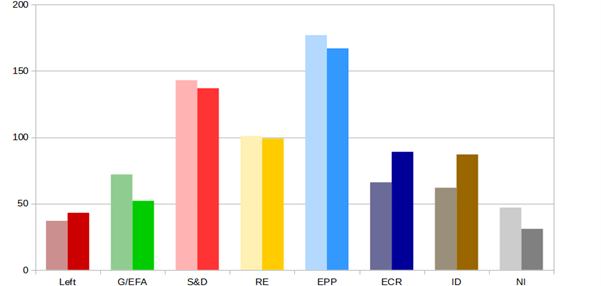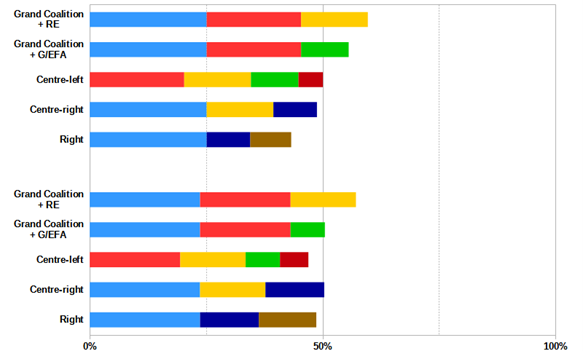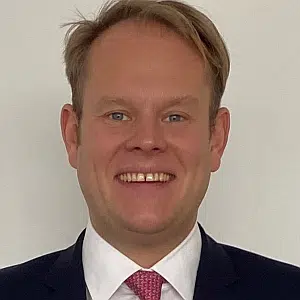In June 2024, the elections for the EU Parliament will be held. The majority emerging from this election will determine the top roles for key EU institutions, such as the EU Commission (EC) President as well as the President of the EU Council of the Heads of State and Government. In the last few years, a grand coalition between the European People’s Party (EPP) and the Socialists and Democrats (S&D) has ruled the EU institutions. However, given the rise of right-wing parties across Europe, there’s an ongoing attempt by the EPP to explore the possibility of breaking the traditional alliance with the S&D and form a new, right-wing coalition, to change the equilibria within the EU. In this article we discuss the likelihood and feasibility of this option.
1. Current Situation: The “Traditional” Grand Coalition, Which Includes The Liberals
Ahead of the 2024 European Parliament (EP) elections, political discussions are intensifying over who will lead the European Institutions in the aftermath. Which parties will form the majority for the upcoming term? Currently, the coalition of EPP, S&D and Renew Europe (RE) holds the majority in the EP. However, in order to be elected, Ursula von der Leyen had to depend on votes outside this coalition to secure her position as the Commission President.
According to the latest polls (Figure 1), the EPP's seats, which are currently 177, will decline slightly to 167 and S&D's seats, currently 143, will also decrease a little to 137. Renew Europe's seats, which are 101 at present, will remain stable at 99. The Greens/European Free Alliance (G/EFA) is expected to experience significant losses, with their seats dropping from 72 to 52. On the other hand, the ECR is predicted to have a notable increase in seats, with their current total of 66 seats likely to increase to 89.[1] These predicted results could lead to the possibility of new edition of a grand coalition between EPP and S&D with Renew.
Figure 1: Seat distribution in the European Parliament. Today (left), projection (right)

2. Will the “Spitzenkandidat system” be reinstated?
According to its statutes, the EPP and its congress will elect the EPP candidate for the President of the EU Commission.[2] This implies that they must select the EPP politician who wishes to run for President if they are to comply with their own rules. If there are multiple nominees, an internal election, like the one between Manfred Weber and Alexander Stubb in late 2018, will be held, and the winner will become the EPP candidate. If Ursula von der Leyen, who is currently the most likely candidate, is announced as the EPP Spitzenkandidat, the other political parties are likely to follow suit and also nominate their front runners.
At their Stockholm Congress, the Alliance of Liberals and Democrats for Europe (ALDE) decided that they will present their Spitzenkandidat for the position of Commission President and anticipate an energetic campaign in 2024. [3] In addition, the S&D is very likely to nominate someone to represent them in the elections, especially if EPP and ALDE nominate their own candidates.
However, a true revival of the Spitzendkandidat system would require certainty that one of the Spitzenkandidaten will actually become the President of the European Commission (EC) in 2024, after the election. This was not the case when the Spitzenkandidat system was first launched. In fact, even if Weber was the Spitzenkandidat for the EPP and the EPP resulted to be the largest party in the EP, eventually Von der Leyen was chosen as EC President.
At this stage, such a certainty could only be attained through an agreement by the European Council to consider only Spitzenkandidaten as the President of the European Commission (EC) after the elections. It is highly unlikely that this will happen. The EU Council does not want to limit its power and room for manoeuvre after the elections that much. The Spitzenkandidat system is also mostly not favoured by the heads of state.
The most likely scenario is as follows. The Spitzenkandidat system will likely be adopted again, but it is again uncertain if one of them will be elected as the EC President after the EU Elections. Like Jean-Claude Junker in 2014, Ursula von der Leyen may become EC President again if she becomes the Spitzenkandidat for the EPP. However, this outcome might not be due to the EU Council's humbleness or to foster the democratic process within the EU decision-making process, but rather as she may be a convenient compromise solution for the EU’s heads of states and governments, during these politically challenging times for Europe. This approach is referred to as “the quality of the candidate” by insiders.
3. What will Von der Leyen do after the elections?
The member states will nominate a candidate for the position of President of the EC through the EU Council, taking into account the results of the European elections. Furthermore, the EP must approve the new Commission President by an absolute majority which is half of the existing MEPs plus one.[4] Von der Leyen is mainly interested in being nominated by the member states for the position and then obtaining approval from the EP. To achieve that, she needs a majority. The previous election has revealed that the coalition of EPP, S&D, and RE, despite having a formal majority, is not united enough to elect Von der Leyen alone.
This is because there were too many dissenters within the ranks of the EPP, S&D and RE. So, she had to rely on votes outside the coalition to secure her election. In that occasion, Von der Leyen was elected with a margin of nine votes - not a significant number when compared to the total of 747 votes. Therefore, she must either secure votes from the G/EFA, who are traditionally neutral but may be swayed by her Green Deal policy, or lobby for votes from the ECR by offering political concessions in fields such as migration. Or pursue both options.
Figure 2: Alliances seat share in the European Parliament today (above), projection (below)

She needs to achieve all of that without losing too many votes from her core camp. To secure her approval by the EP, Von der Leyen must negotiate positions and policies with her coalition as well as with the G/EFA and ECR. Considering the range of actors involved, this job is challenging and demanding. The timetable could also be challenging for her. The constitution of the Parliament will take place on 6-9 June. Due to the summer break, the election of the EC President may not take place before September. There is ample time for things to go wrong.
4. What is the EPP position?
The position of the EPP is relatively clear. The EPP will nominate Ursula von der Leyen if there are no other strong candidates and she herself decides to run. Currently, her chances of keeping the Presidency for the EPP are looking the best. The opposition from the European capitals, particularly Paris and Berlin, is relatively weak. The current PM in Madrid is also in favour of her and Rome could work with VdL as well. Von der Leyen has successfully lobbied to achieve this position in recent years.
5. Is it feasible for the EPP and ECR to come to an agreement?
In general, it seems unlikely. However, in some aspects, it might be possible. The formation of an official coalition between the EPP and the ECR, or even the creation of a group together in the next Parliament, is unlikely due to the opposition of some member parties in the ECR and national political circumstances. For instance, the Polish Law and Justice Party (PIS), the Swedish Democrats (SD), and the Finns Party are not politically acceptable to some EPP members. One has a problem with the rule of law, while others are perceived as openly right-wing extremists.
Manfred Weber, the President of the EPP and Chairman of the EPP Group in the EP, has established specific demands for parties wishing to cooperate. Weber has stated that these parties must be:
- pro-European,
- respect for the rule of law, and
- and on the side of Kiev in the war between Russia and Ukraine.
These demands do not fit for either the PIS, the SD or The Finns. Moreover, the national political constellation is not favourable for these parties, making it difficult for the EPP as a group to form an official coalition with the ECR. Sweden already has two EPP members: Moderaterna (MOD) and the Kristemokraterna (KD). The current members are not inclined to welcome a third and extremist party from Sweden into the EPP. The EPP members from Finland, Kansallinen Kokoomus (KOK) and Suomen Kristillisdemokraatit - SK(KD), do not intend to officially cooperate with The Finns Party, which is Eurosceptic.
However, there is a fourth party in the ECR that is part of the government with one of the EPP members. The Italian governing party of Prime Minister Georgia Meloni is The Brothers of Italy. She fulfills all three demands set by Weber and also has good relations with the EPP member Forza Italia, which needs to secure its political future following the death of Silvio Berlusconi. One possible scenario is that after the elections, The Brothers of Italy could join the EPP, which would contribute to the still uncertain reelection of Ursula von der Leyen as Commission President.
6. What is the potential loss of votes from the Socialists and the Liberals if the EPP allows the ECR to join the majority?
Unofficial collaboration, rather than an official coalition, is beneficial in terms of votes. This situation already occurred in 2019 when Viktor Orban's Hungarian Fidesz party was still a member of the EPP. Both the Socialists and the Liberals have a strong interest in Von der Leyen getting elected once she is with the nomination of the member states and in front of the European Parliament. The EPP can therefore opt for a solution in which ECR votes are “added” to those of the S&D and RE, in order to re-balance the coalition towards the centre-right. The question is: how many dissenters will emerge among the “core” majority if ECR is added to it? The numerical increase may result in political incompatibility, which may eventually lead to the collapse of Von der Leyen’s candidacy.
7. What would be the impact on the European integration process?
If a centre-right coalition were to emerge after the next European election, we would likely see a slow-down of the European integration process, which has been progressing slowly in the last few years. For example, the creation of a Capital Markets Union is still elusive, and even the banking union has been stalled by the dispute on EDIS, the European Deposit Insurance Scheme. Within this slow progress, though, a rapid acceleration occurred during the pandemic, when a Recovery and Resilience Facility (RRF) was created by leveraging on the EU’s budget, allowing the Commission to issue “common debt” (even if without “several and joint guarantee”). If the centre-right coalition were to also include the nationalistic (and openly anti-EU) parties of Democracy and Identity, we could even see the integration process going into reverse mode.
8. What would be the implications for the global economy?
If a centre-right coalition were to emerge at EU level, it is likely that the Commission would be more constrained than it has been in recent years in adopting common, expansionary fiscal measures. This would leave only national governments and the ECB with the task of supporting economic activity, at a time when inflation is still eroding people’s purchasing power. The possible (if unlikely) presence of Democracy and Identity in the coalition could also imply a weakening of the EU support to Ukraine and a likely opposition to the country joining the EU at some point.
All these themes, issues and scenarios will be widely discussed during the course Global Macroeconomic Challenges offered by the LSE to executives willing to understand the intricacies of European integration process and the interconnectedness of the global economy.

